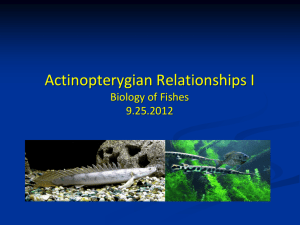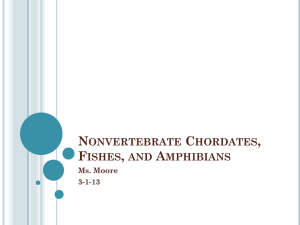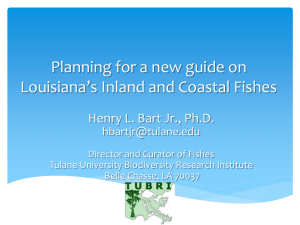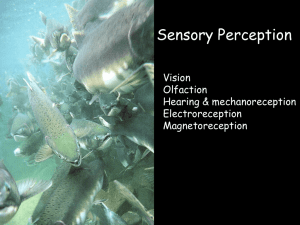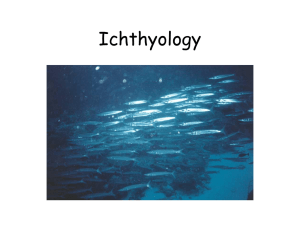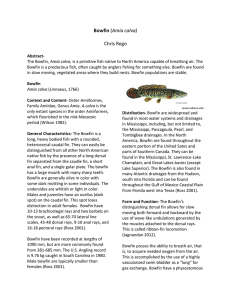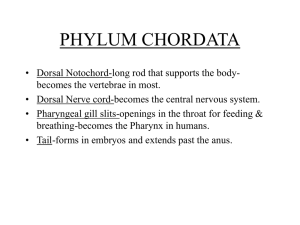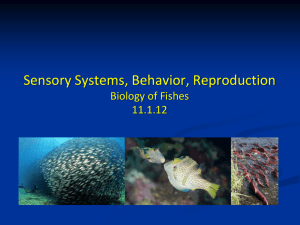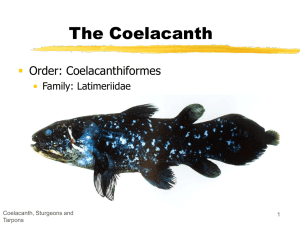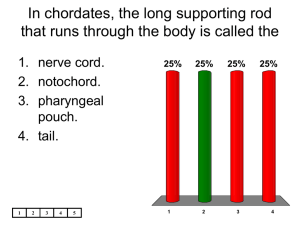Topic 6 Bony fishes primitive groups
advertisement
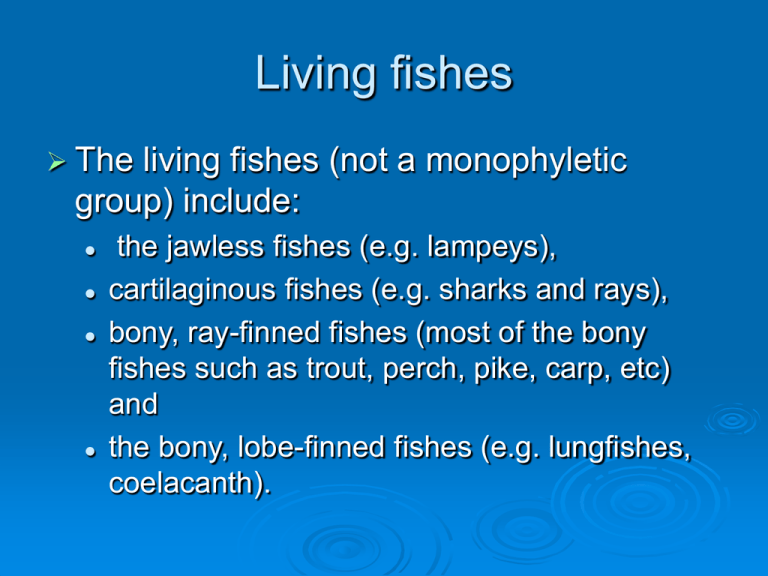
Living fishes The living fishes (not a monophyletic group) include: the jawless fishes (e.g. lampeys), cartilaginous fishes (e.g. sharks and rays), bony, ray-finned fishes (most of the bony fishes such as trout, perch, pike, carp, etc) and the bony, lobe-finned fishes (e.g. lungfishes, coelacanth). Figure 24.01 16.1 Figure 24.02 16.2 Bony fishes: Osteichthyes The term osteichthyes does not describe a monophyletic group, but is a term of convenience to describe the fishes whose skeletons are made of bone that replaces cartilage during embryonic development. There are two classes the Actinopterygii (the ray-finned fishes) and the Sarcopterygii (the lobe-finned fishes) General characteristics of bony fish Skeleton made of bone of endochondral origin (derived from cartilage). Paired and median fins supported by dermal rays. Respiration mainly by gills. Gills covered with operculum. Swim bladder often present. Complex nervous, circulatory and excretory systems present Class Actinopterygii (ray-finned fishes) This is by far the larger of the two living classes of fishes with more than 27,000 species. Includes probably every fish you can think of. E.g. salmon, cod, herring, tuna, marlin, pike, sardine, clownfish, goldfish. Divisions of Actinopterygii The Actinopterygii are divided into two subclasses Chondrostei, which includes several relic species. Neopterygii, which includes the most derived and most recent group of ray-finned fishes the infraclass Teleostei, which includes more than 20,000 species and a small number of primitive species including the gars and bowfins in the infraclass Holostei. Class Actinopterygii Subclass Chondrostei [37 species] Subclass Neopterygii Order Acipenseriformes (paddlefish and sturgeons) Order Polypteriformes (bichirs) Infraclass Holostei [8 species] Order Lepisosteiformes (gars) Order Amiiformes (bowfin) Infraclass Teleostei 12 superorders Ancestral ray-finned fishes Ancestral ray finned fishes in the Devonian were small and heavily armored with ganoid scales • Thick, bony, non-overlapping, relatively inflexible scales. and heterocercal tails (shaped like that of modern sharks). Figure 24.18 Subclass Chondrostei A few relic species still possess such characteristics. These are grouped in the sublass Chondrostei. The Chondrostei include sturgeon and paddlefish which are included order Acipenseriformes and the bichirs (Polypteriformes). Figure 24.19 Subclass Chondrostei The relatively few surviving Chondrostei are the remnant of what was once a much more diverse group. The chondrosteans were the first bony fishes and were most diverse in the Carboniferous and Permian. Subclass Chondrostei Early chondrosteans were mostly small < 0.5m with a fusiform shape which suggests they were active foragers. They were covered with small diamondshaped scales. The base of each scale was made of bone, the middle of dentin and the surface with an enamel-like substance called ganoine. Hence the name ganoid scales. Order Acipenseriformes: Sturgeons and Paddlefish Modern Acipenseriform fish are almost scaleless except for in sturgeons, which have a few isolated rows of large plate-like, boney ganoid scales scales that run along the sides of the body. The skeleton is almost entirely cartilaginous, which has resulted from the loss of mineralization. Vertebrae are poorly developed and the notochord is large. Both groups have distinctive forked heterocercal tails and both have enlarged rostrums. Paddlefish The two species of paddlefish are found in fresh water in North America and China. The Chinese species known only from the Yangtze may be extinct. About 2m long, paddlefish possess a distinctive elongated flattened rostrum, which is believed to be used to detect tiny, electric fields. The North American paddlefish occurs in the Mississippi River watershed and is one of North America’s largest freshwater fish (commonly 5 feet and 60lbs, record official weight is 144lbs). http://blocs.xtec.cat/englishcornersallaresipla/files/2008/01/paddlefish2.jpg Paddlefish Paddlefish are filter feeders that sieve zooplankton from the water using filaments on their gill rakers. The rostrum’s ability to detect electric fields is thought to help in finding prey, but fish with damaged or missing rostrums do not appear to be handicapped. Paddlefish Previously paddlefish were abundant in most central U.S. river systems. However, numbers have declined because dams have prevented the fish from reaching their spawning areas and as a result of poaching for their eggs. Missouri paddlefish clip http://www.youtube.com/watch?v=fysqA0tr 4qo Sturgeons Sturgeons have been around and little changed for about 200 million years and are some of the most ancient rayfinned fishes. There are 24 species of sturgeons, which are native to subtropical, temperate and sub-Arctic rivers, lakes and coasts of Eurasia and North America Sturgeons are very distinctive being very large (up to 6m in length and 2000kg in weight) with heavy bony scutes rather than scales and a distinctive flattened rostrum and barbels. http://www.fishingmagic.com/news/images/Canada_Record_Sturgeon_lg.jpg http://fish.dnr.cornell.edu/nyfish/Acipenseridae/shortnose_sturgeon.jpg Sturgeons Sturgeons are anadromous, spawning upstream but feeding in river deltas and estuaries. Sturgeon are bottom feeders and have a protrusible jaw (evolved independently of the teleosts) which they use for suction feeding. They use their snout to stir up sediment and use their barbels to detect small invertebrates and fish. They possess no teeth and so cannot seize prey, but can swallow quite large fish whole. Sturgeons They are commercially important for their meat, but especially their eggs (caviar). http://cordonnoir.com/images/Caviar_fresh.jpg Sturgeons Sturgeon are long-lived (some living well over 100 years) and slow reproducing (they don’t become sexually mature until 20 or more years of age, which makes them very vulnerable to fishing pressure. Most species are considered to be at risk of extinction. Canadian Lake Sturgeon clip http://www.youtube.com/watch?v=aCMNB qg6fH4 Class Actinopterygii Subclass Chondrostei [37 species] Subclass Neopterygii Order Acipenseriformes (paddlefish and sturgeons) Order Polypteriformes (bichirs) Infraclass Holostei [8 species] Order Lepisosteiformes (gars) Order Amiiformes (bowfin) Infraclass Teleostei 12 superorders Order Polypteriformes: Bichirs There are 10-15 species [depends on the authority] of bichir and they are considered the most primitive surviving group of the ray-finned fishes. They are heavily armored with dermal bone and a thick layer of ganoid scales. Dorsal fin is distinctive and has independent rays and is segmented into small “flags” called pinnules. Generally elongated, eel-like in shape up to 1.2m in length. Armored Bichir http://www.aquarticles.com/images/Gallo/Armoured%20bichir%202.gif http://www.fbas.co.uk/Bichir.jpg Order Polypteriformes: Bichirs Bichirs are warm water fish and are found in swamps and streams in Africa. They hunt at twilight and lie in wait on the bottom for prey to pass by. They will take any suitably sized aquatic animal. Order Polypteriformes: Bichirs Bichirs have a swim bladder that acts like a paired ventral lung. They will drown if unable to gulp air at the surface. Larvae have external gills very similar to those of amphibians. The lungs allow bichirs to survive in low oxygen environments. They can also survive buried in silt or outside water during the dry season. Order Polypteriformes: Bichirs Because bichirs have paired fleshy pectoral fins and lungs they were formerly classified with the lungfishes, but are now considered to have evolved these traits independently. Bichirs are a popular aquarium fish Bichir clip http://www.youtube.com/watch?v=SEpqY3 NJIIg Class Actinopterygii Subclass Chondrostei [37 species] Subclass Neopterygii Order Acipenseriformes (paddlefish and sturgeons) Order Polypteriformes (bichirs) Infraclass Holostei [8 species] Order Lepisosteiformes (gars) Order Amiiformes (bowfin) Infraclass Teleostei 12 superorders Neopterygii: infraclass Holostei There are two orders of primitive Neopterygians grouped together in the infraclass Holostei Both have more flexible jaws than chondrosteans, but these are less flexible than those of more advanced Neopterygians. These are the seven species of gars (Lepisosteiformes) and the single species of bowfin (Amiiformes). Order Lepisosteiformes: Gars Gars are medium to large (1-3m) predatory fish with a distinctive elongated body and long jaws filled with sharp teeth. Found now only Central and North America and the Caribbean gars are last survivors of a once more widely distributed group that was widespread in the Mesozoic. They have hard, interlocking, multilayered ganoid scales which provide excellent protection and are similar to the scales of many extinct Paleozoic and Mesozic actinopterygians. Note heterocercal tail, and dorsal fins are located close to the tail and long jaws. http://animals.nationalgeographic.com/staticfiles/NGS/ Shared/StaticFiles/animals/images/primary/gar.jpg Longnose gar http://www.biokids.umich.edu/files/12296/gar_large.jpg Order Lepisosteiformes: Gars Occur in slow moving water bodies preferring shallow and weedy areas. They are voracious predators and feed on a wide range of vertebrate and invertebrate prey. Gar are tough hardy freshwater fish that can survive in stagnant or warm water where oxygen levels are low. Vascularized swimbladder functions as lungs (as in related bowfin). Order Amiiformes: Bowfin There is only one species of bowfin still extant, the only survivor of a group that was previously more diverse in the Jurassic and Cretaceous. Bowfins occur throughout eastern North America, typically in slow moving fresh water. When oxygen levels are low bowfin will gulp air from the surface into the heavily vascularized swimbladder, which can serve as a lung. Bowfin http://pond.dnr.cornell.edu/nyfish/Amiidae/bowfin.jpg Bowfin possess a distinctive long dorsal fin and a black “eyespot.” Order Amiiformes: Bowfin Scales are of a single layer of bone as in teleosts, but the caudal fin is asymmetric and similar to that of more primitive fishes. The skull is much more solid and heavily built than that of teleosts Bowfin are aggressive predators that feed on a wide variety of invertebrate and vertebrate prey. Bowfin skull http://bio.sunyorange.edu/updated2/THINKING_EVOLUTION/anatomy1a/s_face.htm Bowfin http://www.savalli.us/BIO370/Diversity/04.OsteichthyesImages/BowfinL.jpg
